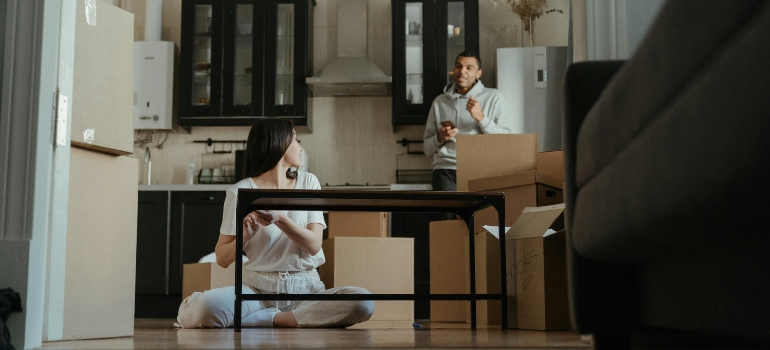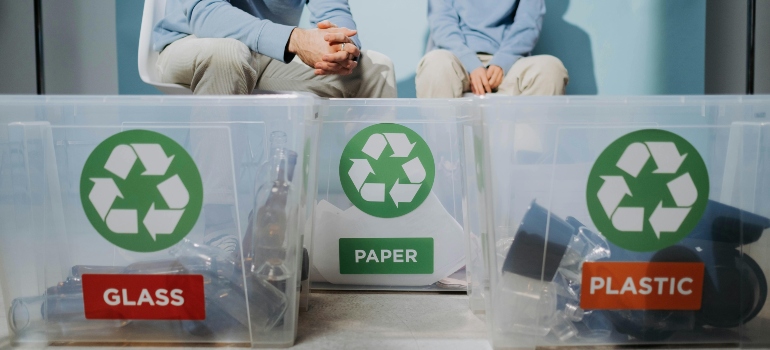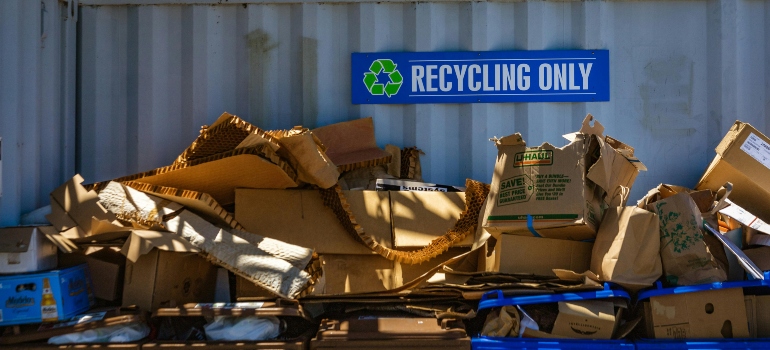Green Alternatives to Traditional Packing Materials
Packing materials often serve a single purpose, only to end up in Seattle landfills. Traditional materials like plastic bubble wrap, Styrofoam, and packing tape are significant contributors to environmental pollution. As Seattlites strive for a more sustainable lifestyle, adopting alternatives to traditional packing materials is no longer optional—it’s necessary. Eco-friendly packing materials not only reduce waste but also lower the carbon footprint of moving, shipping, and storage activities. So, let our longstanding movers and packers in Seattle introduce practical solutions emphasizing options that are effective, affordable, and environmentally sound.
Why Traditional Packing Materials Fall Short
Traditional packing materials, while effective at protecting items, have significant environmental drawbacks. Styrofoam, for instance, takes hundreds of years to decompose and releases harmful chemicals during production. Plastic bubble wrap, though lightweight and convenient, contributes to the growing issue of microplastic pollution in oceans and soil.
Another challenge with traditional materials is their reliance on fossil fuels for production. This process emits greenhouse gases, exacerbating climate change. These materials are often difficult to recycle due to contamination or lack of accessible facilities, leaving most of them to sit in landfills.
The growing awareness of these problems is driving individuals and businesses to explore sustainable alternatives. Making small changes to your packing process can significantly reduce environmental harm while maintaining efficiency and protection.

Eco-Friendly Packing Materials You Can Try Today
The shift to sustainable packing materials has led to the development of innovative solutions that balance protection, affordability, and environmental responsibility. These alternatives to traditional packing materials cater to various needs, ensuring that even fragile items are well-protected during transit. Below are some of the most practical options you can start using today.
Biodegradable Packing Peanuts
Biodegradable packing peanuts function like their Styrofoam counterparts but are made from renewable materials such as cornstarch or wheat. These peanuts are lightweight and provide excellent cushioning, making them ideal for protecting fragile items during moving with Washington movers or shipping.
What sets them apart is their ability to dissolve in water. This eliminates waste and makes disposal simple. The peanuts are also non-toxic, making them a safer option for homes with pets or children. Many retailers now stock biodegradable peanuts, so they are easy to source.
Recycled Cardboard and Paper
Recycled cardboard and paper remain some of the most accessible and versatile green packing materials. Shredded paper can be used as filler for boxes, while cardboard can be cut or folded to create protective layers for fragile items.
These materials are cost-effective and readily available, making them a popular choice for both personal and commercial packing. By using recycled materials, you also contribute to reducing the demand for new paper products, helping conserve natural resources like trees and water.
Mushroom-Based Packaging
One of the most innovative materials in recent years is mushroom-based packaging. Made from mycelium, the root structure of mushrooms, this material grows into custom molds that can fit your packing needs. Once discarded, it breaks down naturally in compost without leaving any toxic residues.
Mushroom-based packaging is especially useful for items that require rigid protection, such as electronics or delicate ornaments. While slightly pricier than traditional materials, its durability and biodegradability make it a worthwhile investment for eco-conscious businesses relocating with office movers in Seattle as well as individuals and families.
Corrugated Bubble Wrap
For those who rely on bubble wrap to protect fragile items, corrugated bubble wrap offers a sustainable alternative. This material is made from recycled cardboard and has a similar cushioning effect as traditional bubble wrap. Its layered structure ensures durability while being easy to recycle after use.
Corrugated bubble wrap is particularly effective for wrapping glassware, dishes, or artwork. It’s lightweight and can be cut to size, minimizing waste. When you switch to this material, you can enjoy the benefits of traditional bubble wrap without the environmental drawbacks.
Creative Ways to Reuse Items as Packing Materials
Adopting eco-friendly packing doesn’t always require buying new products. Often, items already in your home can serve as effective and green alternatives to traditional packing materials. This approach not only reduces waste but also saves money by repurposing everyday items.
Household Fabrics
Household fabrics, such as old clothes, towels, or linens, are excellent for wrapping and cushioning items. Thick fabrics like sweaters or blankets can protect fragile objects, while smaller items like socks can fill gaps in boxes to prevent shifting. It offers a double benefit: it protects your belongings and helps declutter your home. When the moving services in Seattle are complete, you can wash and reuse the fabrics, making this an entirely waste-free solution.

Newspaper and Magazines
Old newspapers and magazines are other versatile options. They can be crumpled to fill empty spaces in boxes or wrapped around items to provide cushioning. For delicate items, layering the paper adds extra protection. While newspapers are recyclable, they can also be composted if the ink used is non-toxic. This makes them an environmentally friendly alternative to bubble wrap or foam.
Egg Cartons and Toilet Paper Rolls
For small or fragile items, egg cartons, and toilet paper rolls offer sturdy, compact protection. Jewelry, ornaments, or small gadgets can fit snugly inside these materials, preventing damage during transit. Egg cartons, in particular, are made from biodegradable materials, adding to their eco-friendly appeal. They are lightweight and easy to source, making them a practical choice for anyone packing on a budget.
Innovative Commercial Products Leading the Way
The demand for sustainable packing solutions has driven companies to create innovative products that cater to both individual and commercial needs. These materials combine cutting-edge technology with environmental consciousness, making them effective and planet-friendly.
Seaweed-Based Packaging
Seaweed-based packaging is an emerging alternative gaining traction due to its renewable and biodegradable properties. Made from algae, this material is versatile and can be molded into various shapes, including sheets or pouches. This type of packaging works well for items that need lightweight protection. It decomposes quickly, even in home compost systems, and requires fewer resources to produce compared to traditional plastics.
Plant-Based Plastic Alternatives
Plant-based plastics, such as polylactic acid (PLA), are derived from renewable resources like corn starch or sugarcane. These plastics mimic the durability of traditional materials while being biodegradable under the right conditions.
Although plant-based plastics are not always suitable for home composting, they break down in industrial facilities, making them a more sustainable option for large-scale packing needs. They are ideal for food-grade packaging or lightweight protective layers.
Air-Packed Recyclable Pillows
Recyclable air pillows offer another eco-friendly solution for filling empty spaces in boxes. Made from recycled plastic or paper, these pillows provide cushioning while being reusable or recyclable after use. Air-packed pillows are lightweight, reducing shipping costs, and their compact design allows for easy storage when not in use. When you choose products made from recycled materials, you help reduce the demand for virgin plastic.

How to Reduce Packing Waste Beyond Materials
Switching to eco-friendly materials is a significant step, but reducing packing waste also involves adopting smarter practices. If you rethink how you pack, you can minimize material use while ensuring your items are secure. Below are some effective strategies.
Minimalist Packing Practices
Efficient packing starts with organizing your items. Use smaller boxes to avoid empty spaces, and group items by size to maximize space. For fragile items, consider using clothing or towels as protective layers instead of separate materials.
Another useful tip is to disassemble bulky items like furniture or electronics. This makes them easier to pack and reduces the need for extra padding. By being mindful of how much material you use, you can significantly cut down on waste.
Rental and Reusable Packing Boxes
Reusable packing boxes are becoming increasingly popular among eco-conscious movers. These boxes, often made of durable plastic or recycled materials, can be rented for short-term use. Once you’re done, you return them for cleaning and redistribution, ensuring they don’t contribute to waste.
Many companies offer delivery and pickup services for these boxes, making the process convenient. Using rental boxes eliminates the need for disposable cardboard, which is often discarded after a single use.
Cost-Effectiveness of Eco-Friendly Packing
A common misconception about sustainable packing materials is that they are more expensive. While some eco-friendly options have higher upfront costs, they often prove cost-effective in the long run. Reusing materials and reducing waste also help offset expenses. This is how green packing saves you money:
- Lower Shipping Costs: Lightweight materials like biodegradable peanuts or air pillows reduce the overall weight you move with shipping companies in Seattle, saving on freight charges.
- Reuse and Repurpose: Household items like towels, clothing, or newspapers eliminate the need to buy new packing materials.
- Durability: Reusable options, such as rental boxes or mushroom-based packaging, are designed for multiple uses, spreading their cost over time.
- Local Sourcing: Many green materials can be sourced locally, cutting transportation costs and environmental impact.
Embracing eco-friendly alternatives to traditional packing materials doesn’t just benefit the planet; it also helps you make smarter financial decisions.
The Future of Green Packing Innovations
The future of packing is defined by creativity and technology. Edible packaging, made from materials like seaweed, offers an exciting way to eliminate waste entirely. This innovation is particularly promising for the food industry, where packaging contributes significantly to waste. Similarly, advancements in nanotechnology are paving the way for ultra-light, durable materials that require fewer resources to produce and are fully biodegradable.
Smart packaging is another emerging trend. Equipped with sensors to monitor conditions like temperature and humidity, these materials help reduce spoilage and waste, especially in the transportation of perishable goods. As consumer demand for sustainable options grows, these innovations will play a critical role in reshaping the packing industry.
Encouraging Green Practices with an Extensive Checklist
Making sustainable packing choices becomes easier with clear steps to follow. Here’s a checklist to streamline the transition:
1. Use Sustainable Materials
- Biodegradable packing peanuts.
- Mushroom-based packaging for rigid protection.
- Recycled cardboard and shredded paper.
- Corrugated bubble wrap or recyclable air pillows.
2. Adopt Reusable Solutions
- Rent or purchase durable packing boxes.
- Use household fabrics for cushioning.
- Repurpose egg cartons or paper rolls for small items.
3. Optimize Packing Practices
- Group items tightly to minimize material use.
- Disassemble bulky items to reduce the need for padding.
- Prioritize lightweight materials to lower shipping costs.
4. Dispose Responsibly
- Recycle or compost biodegradable materials.
- Donate reusable items like boxes to charities.
- Partner with recycling programs to handle leftover packing waste.
Adopting sustainable packing practices is all about a mindset shift toward responsibility and innovation. Every action, whether it’s repurposing old fabrics or investing in biodegradable options, contributes to a larger goal creating a ripple effect that drives industry-wide change.

Supporting Healthier Communities Through Sustainable Packing
Choosing eco-friendly packing materials does more than reduce waste and save money with long distance movers in Seattle—it also supports healthier communities by minimizing pollution and promoting cleaner environments. Traditional packing materials, such as plastic bubble wrap and Styrofoam, often release harmful chemicals during production and decomposition. These substances can leach into the soil and water, impacting ecosystems and potentially entering food chains.
Therefore, you help lower the demand for resource-intensive production processes that contribute to air and water pollution simply by switching to biodegradable or recycled alternatives. For example, mushroom-based packaging decomposes naturally without leaving toxic residues, while recycled cardboard reduces deforestation and conserves water used in producing virgin paper products.
Sustainable packing choices also foster a sense of environmental responsibility within communities. When individuals and businesses prioritize eco-friendly solutions, they encourage local governments and organizations to adopt and promote similar practices. This collective effort leads to cleaner neighborhoods, healthier ecosystems, and improved quality of life for everyone.
Shaping a Sustainable Packing Future
Green alternatives to traditional packing materials are no longer optional—they are essential for a sustainable future. From biodegradable peanuts to advanced innovations like edible packaging, these solutions provide effective and environmentally responsible options for individuals and businesses alike. Reducing waste, adopting reusable practices, and exploring innovative materials ensure that packing contributes less to landfills and more to a healthier planet. Every small change, whether it’s using recycled cardboard or renting reusable boxes, brings us closer to a sustainable packing standard that benefits everyone.
Why Choose Us
History
Hansen Bros. Moving & Storage is locally owned and operated by the same family for four generations, since 1890. We have a well-established reputation for service quality and reliability with a high percentage of repeat household and commercial clients.
Professionalism
We’re a certified ProMover by the American Moving and Storage Association with A+ rating with the Better Business Bureau, voted “Best in Western Washington” in 2009 and from 2011 to 2016 by KING5. Our company is fully licensed and insured and member of WMC and AMSA.
Value
Hansen Bros. Moving & Storage provide free, no-obligation in-home estimate and competitive rates, including low minimum rates for shipments moving under 300 miles. We’ve set a refund policy for unused packing materials and three Puget Sound locations to help clients save on travel fee costs.



